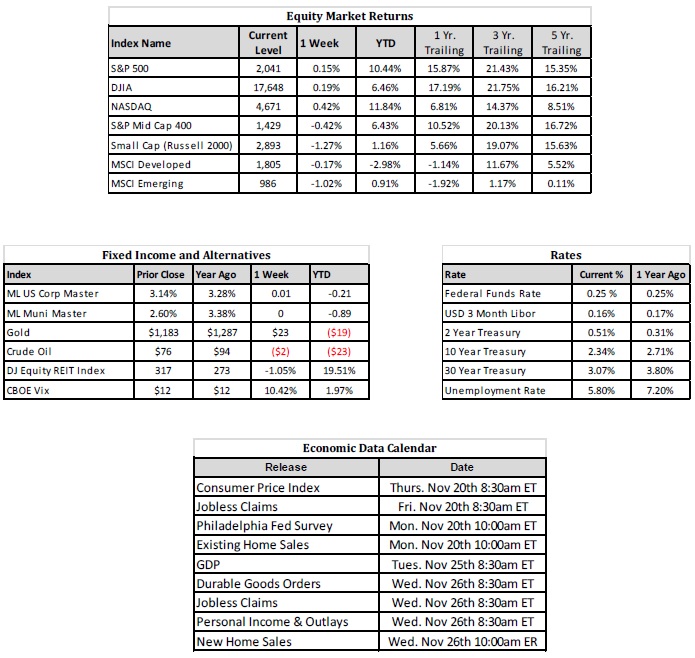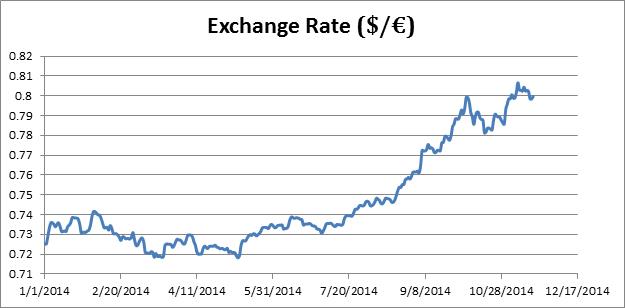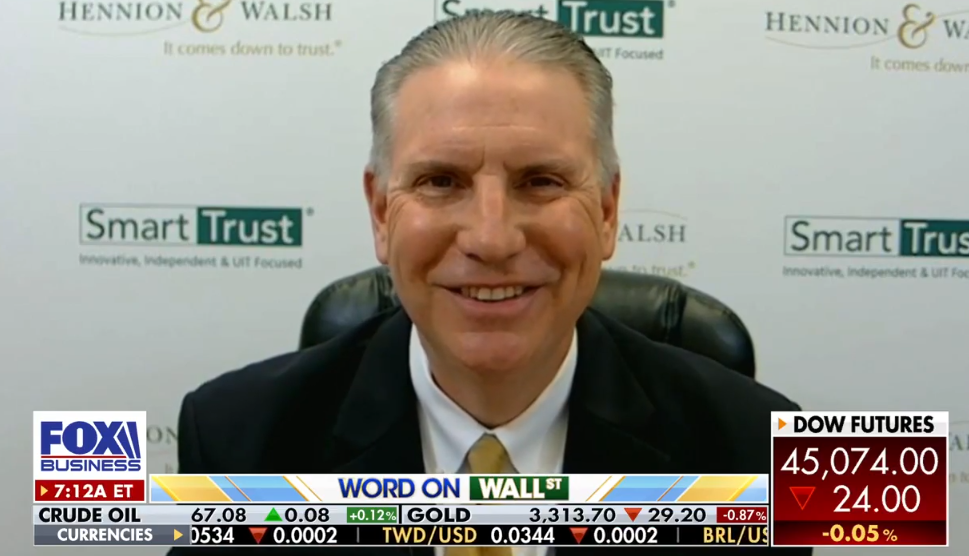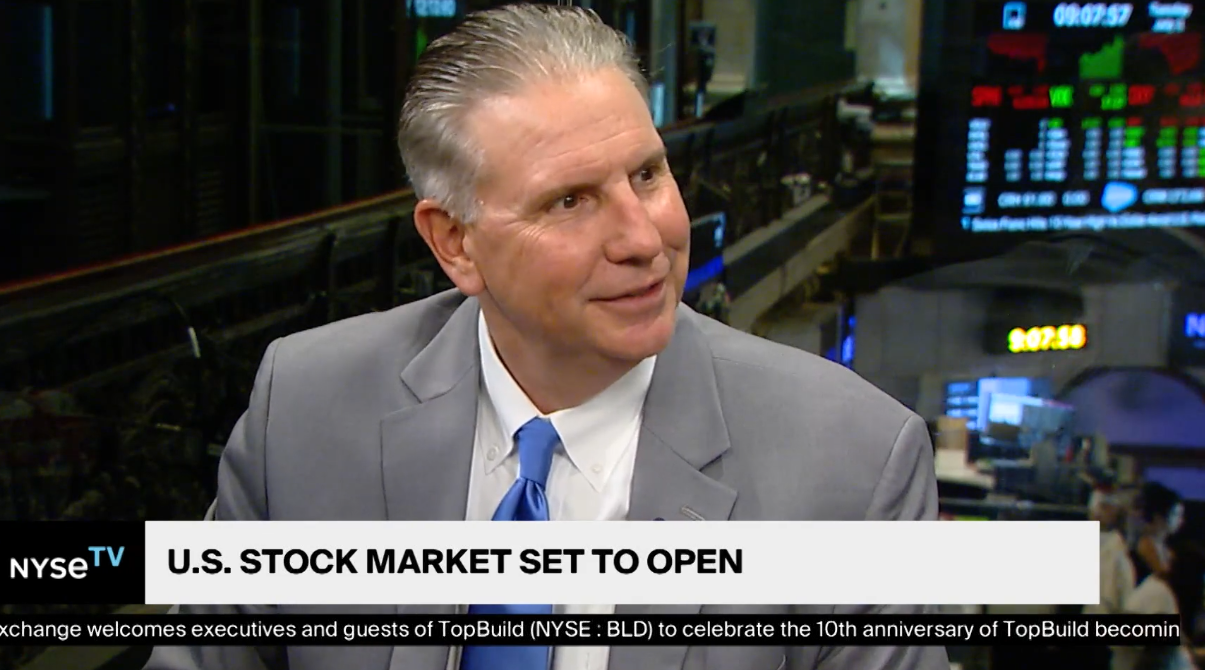
Capital Markets Update – Week of 11/17/2014
Market Overview
Sources: Rates Data and Economic Calendar—Bloomberg Markets as of 11/17/14; Equity Market Returns and Fixed Income and Alternatives Data—Wells Fargo Advisers as of 11/14/14.
Happening Now
US Dollar Strength Affecting International Equity Investments
The dollar has appreciated 12.1% relative to the Euro since hitting a 2014 low in May when it traded for $1.39/EUR. It should be noted that there are a variety of factors that influence global exchange rates, however, and Central Banks appear to be at the heart of the movement witnessed since May. On one side is the European Central Bank (ECB) which is embarking upon a mission to increase the size of their balance sheet to €3 Trillion through the purchase of asset backed securities. The head of the ECB, Mario Draghi, has also discussed the flexibility of the type of assets that will be purchased suggesting that sovereign debt could be considered in order to ensure their balance sheet goals are met. On the other side is the U.S. Federal Reserve, which is beginning the slow process of reversing course and becoming less accommodative. As has been well publicized, the Fed concluded its tapering process in October and many believe (including us) that they will likely begin to raise interest rates sometime during the first half of 2015.
Monetary easing and tightening by design has a direct effect on interest rates. When set in a global context, these actions can have a direct effect on exchange rates. All things being equal, when a country or economy is offering a higher interest rate, some investors may choose borrow in their local market, buy bonds in the foreign market and earn the difference in interest rates. This is known as a type of carry trade and so long as exchange rates stay stable the strategy enables an investor to earn a positive rate of return. The shift in supply and demand, however, caused by investors buying higher yielding currencies and selling lower yielding currencies, forces the exchange rate to change. As a result, higher yielding currencies often appreciate while lower yielding currencies depreciate (relative to each other.)
The current divergence of global Central Bank policies suggests higher interest rates in the U.S. and lower rates in the Eurozone for the foreseeable future. This is one of the reasons that the U.S. Dollar has appreciated relative to the Euro and has lowered the returns of unhedged U.S. investors who own foreign stocks. To illustrate this point further, consider a US investor that sells foreign stock, receives Euros in return, and has to convert those Euros back to U.S. Dollars. If the Dollar is more expensive than it was when the trade was initiated, the investor will receive less and will have a lower total return. So, the total return for a U.S. investor that owns foreign stock is not just the foreign market return but the foreign market return plus the return on the foreign currency. Many investors in the U.S. have come to now expect this scenario since the Euro has fallen 10.1% in 2014.
* As of 11/18, the US Dollar has appreciated 11.2% in 2014
According to Morningstar as of 11/17/2014, the MSCI EAFE index in USD has experienced a loss of 3.38% thus far in 2014, while the MSCI EAFE in local currencies has returned a positive 2.22%, a difference of over 5.5%. This is even more dramatically exhibited when looking at the MSCI index that focusses on Europe alone. While we do not suggest individual investors hedge currency returns by purchasing a derivative, we strongly recommend that anyone diversified internationally understand the potential effects that exchange rates may have on their total returns.
Sources:
Exchange Rate Data- https://www.ecb.europa.eu/stats/exchange/eurofxref/html/eurofxref-graph-usd.en.html
Local and US Index Returns- http://news.morningstar.com/index/indexReturn.html
Important Information and Disclaimers
Past Performance is not a guarantee of future performance.
Investing in foreign securities presents certain risks not associated with domestic investments, such as currency fluctuation, political and economic instability, and different accounting standards. This may result in greater share price volatility. These risks are heightened in emerging markets.
There are special risks associated with an investment in real estate, including credit risk, interest rate fluctuations and the impact of varied economic conditions. Distributions from REIT investments are taxed at the owner’s tax bracket.
The prices of small company and mid cap stocks are generally more volatile than large company stocks. They often involve higher risks because smaller companies may lack the management expertise, financial resources, product diversification and competitive strengths to endure adverse economic conditions.
Investing in commodities is not suitable for all investors. Exposure to the commodities markets may subject an investment to greater share price volatility than an investment in traditional equity or debt securities. Investments in commodities may be affected by changes in overall market movements, commodity index volatility, changes in interest rates or factors affecting a particular industry or commodity.
Products that invest in commodities may employ more complex strategies which may expose investors to additional risks.
Investing in fixed income securities involves certain risks such as market risk if sold prior to maturity and credit risk especially if investing in high yield bonds, which have lower ratings and are subject to greater volatility. All fixed income investments may be worth less than original cost upon redemption or maturity. Bond Prices fluctuate inversely to changes in interest rates. Therefore, a general rise in interest rates can result in the decline of the value of your investment.
Definitions
MSCI- EAFE: The Morgan Stanley Capital International Europe, Australasia and Far East Index, a free float-adjusted market capitalization index that is designed to measure developed-market equity performance, excluding the United States and Canada.
MSCI-Emerging Markets: The Morgan Stanley Capital International Emerging Market Index, is a free float-adjusted market capitalization index that is designed to measure the performance of global emerging markets of about 25 emerging economies.
Russell 3000: The Russell 3000 measures the performance of the 3000 largest US companies based on total market capitalization and represents about 98% of the investible US Equity market.
ML BOFA US Corp Mstr [Merill Lynch US Corporate Master]: The Merrill Lynch Corporate Master Market Index is a statistical composite tracking the performance of the entire US corporate bond market over time.
ML Muni Master [Merill Lynch US Corporate Master]: The Merrill Lynch Municipal Bond Master Index is a broad measure of the municipal fixed income market.
Investors cannot directly purchase any index.
LIBOR, London Interbank Offered Rate, is the rate of interest at which banks offer to lend money to one another in the wholesale money markets in London.
The Dow Jones Industrial Average is an unweighted index of 30 “blue-chip” industrial U.S. stocks.
The S&P Midcap 400 Index is a capitalization-weighted index measuring the performance of the mid-range sector of the U.S. stock market, and represents approximately 7% of the total market value of U.S. equities. Companies in the Index fall between S&P 500 Index and the S&P SmallCap 600 Index in size: between $1-4 billion.
DJ Equity REIT Index represents all publicly traded real estate investment trusts in the Dow Jones U.S. stock universe classified as Equity REITs according to the S&P Dow Jones Indices REIT Industry Classification Hierarchy. These companies are REITSs that primarily own and operate income-producing real estate.





